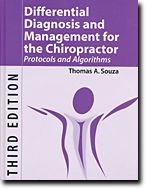|
|
Differential Diagnosis Management for the Chiropractor; Protocols and Algorithms, 3rd edition
Book Review
by
Steven Lavitan, DC, LAc
| Title: |
Differential Diagnosis Management for the Chiropractor; Protocols and Algorithms, 3rd edition |
| Author: |
Thomas A. Souza, DC, DACBSP
|
| Publisher: |
Jones and Bartlett Publishers, 2005
|
| Price: |
$114.95
|
| Part #: |
T-266 |

In life, certain items make a natural pairing. The famous song makes the analogy to a horse and carriage; a writer needs a dictionary and a thesaurus. And chiropractors who believe it is incumbent upon them to make a diagnosis need Brown's book on physical diagnosis and Souza's encyclopedia of differential diagnosis algorithms.
Everyone should read Brown's book from cover to cover, because it is succinct, but Souza's book is a long and difficult task. In my attempt, the medical dictionary was open the whole time. One would think that the typical chiropractor would use it as a reference source and read only a chapter or so at a given time.
The book undoubtedly took years to write, and my guess is that the fourth edition is being worked on even now. It is well over a thousand pages, with each page jam-packed with information. The book obviously stands by itself, but in this computer age, there are people who prefer information that can be accessed electronically and in printed form. A CD accompaniment would be a logical addition.
The book has nine sections, with multiple chapters in each one. The sections are comprehensive and address Musculoskeletal Complaints, Neurologic Complaints, General Concerns, Gastrointestinal Complaints, Genitourinary Complaints, Cardiopulmonary Complaints, Head and Face Complaints, Special Conditions, and Special Patient Groups, respectively.
An algorithm is a flow chart that computer programmers (among others) use to make decisions. Nurse practitioners are required to follow algorithms and are extremely effective in what they do. When chiropractors follow these flow charts, what they do is logical and defensible - not a small matter in this litigious society. When you marry this to acceptable protocols, you are on terra firma. Algorithms ask a question, and the answer to that question describes either what the diagnosis is or generates additional questions. Most answers are discrete, rather than on a continuum, which as a practical matter, means either a yes or a no. Not all diagnostic criteria can be so clearly delineated.
You might argue, shouldn't we know the algorithms, whether or not all diagnoses will fit in easily? The answer is a spectacular yes. Although most of us don't know exactly what Drs. Sarnat and Winterstein required of the chiropractors in the Illinois BC/BS study, we could surmise algorithms and protocols were among the most important requirements.
Ruling out conditions and referring out patients who should receive medical care is a good way to care for people. There are red-flag patients who require immediate referral, and then there are yellow-flag patients who, due to psychosocial considerations, are unlikely to respond to care. This book alludes to both.
Each chapter starts with the algorithm about a specific complaint, followed by no-nonsense cause, evaluation and management discussions of each diagnosis. If we go to the classic initial screening of a patient with chest pain, there are six category questions. Included in that list is the question of whether the pain is diffuse with radiation to the medial arm and/or the jaw.
If the answer is yes, the next question is, "Is it relieved by rest?" If the answer is yes, the patient probably has stable angina. If the answer is no, because it occurs at rest, but is relieved by nitroglycerin, the patient may have Prinzmetal's or unstable angina. If the answer to both of those is no, because the patient doesn't get relief from either method, myocardial infarction may be the diagnosis. With all three, the patient should get a cardiac workup; with the last one, it had better be urgent.
This method is not trying to make chiropractors into cardiologists, but by understanding their position as primary care providers, they should be good health care teammates. In the end, our purpose is to serve our patients. Differential Diagnosis Management for the Chiropractor helps the chiropractor do that better, and it would be a valuable addition to any DC's library. It is highly recommended and was a pleasure to review.
Dr.
Lavitan's
Rating:
 10 out
of 10 10 out
of 10
|

|








